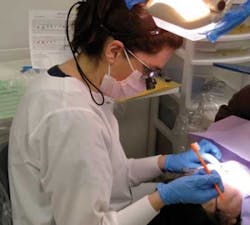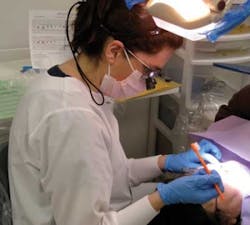Seizing the day
How to come up with a proposal for the decision makers that will allow you to take control of your environment
by Shirley Gutkowski, RDH, BSDH, FACE
There comes a time in every dental hygienist's career when he or she asks the boss for a piece of equipment and the boss says no. Bosses give many reasons for their negative answers, such as it's cold outside, or hot outside. They give the same reasons that any of us do.
But you want a real answer. Well, there are many choices for why the answer may not be the one you want to hear. There may be an expansion coming up. There may be a downturn expected for some reason. The practice owner may think it's a waste of resources to buy the whatchamacallit you want.
Most dental offices have a secret closet where new things go to die. Many products that didn't live up to their hype or were too hard to figure out languish in the closet. On the day you asked for your new gizmo, the practice owner may have been acutely aware of how much money sits in that closet.
Everyone can get caught up in the thrill of a purchase. Even dentists get wrapped up in products that end up not performing. And you know all about this – the dentist buys something he or she expects the hygienist to use and you hate it. It's often time consuming, and it makes the practice money, but all you get out of it is stress. We all know what stress does to one's attitude.
So now we have a situation, right? We have a standoff. The doctor doesn't want to buy you a new whatchamacallit, because the last whatchamacallit he bought for the hygienist before you is in the closet.
What if you bought the whatchamacallit yourself? Seriously. What if you take one of those 0% credit offers that keep coming in the mail and purchase the whatchamacallit yourself? But what are you going to do with an Air Techniques Spectra Caries Detection Aid? You can only use it in the office; you can't take it home and use it for anything else. Maybe a headlight is a good place to start. The new Freedom wireless head-mounted light would be a great investment in your own health. You can pay it off for a while and get a good rate if you're a member of the American Dental Hygienists' Association. So why not? Buying something for your own health is a good way to start.
What if you want to provide better care for your patients? What if you want to discern the difference between cariogenic and noncariogenic biofilm on your patients' teeth to open up some serious discussion?
1,2 In order to get a new instrument, the first step is to really want it. Check. The second step is to figure out who you need to convince to purchase it and what motivates that person. Then write a proposal that illustrates how the person can have his or her needs met while helping meet your needs. One way to start is to create a Mind Map. A Mind Map (Figure 1) shows some of the reasons you may want to purchase the Spectra. Being able to determine the depth of decay is important to any attempts at remineralization. You can find directions to a Mind Map online or in the book "The Purple Guide: Paper Persona Workbook."The main idea of a Mind Map is to have a central idea. You can see that the circle labeled Determine Enamel has two circles coming off of it. These represent how the Spectra helps determine the quality of enamel. The circle that says Needs Remin could have other circles around it reflecting how you plan to use Spectra, such as following areas of enamel breakdown and how it responds to remineralization therapies.
The main idea circle for a Mind Map about the headlight may include physical and ergonomic benefits, as well as not having to mess with a battery pack and wires. If you were designing an idea to work more or fewer hours, the central idea would be "work fewer hours," and the circles around it would include how you'd get all your work done in less time, how much scattered downtime you have currently and how it, when added together, accounts for the time you want to be out of the office.
So now you have a little framework around what you want. You've brought up some ideas and organized them in an organic fashion. It's time to put your Mind Map into an outline.
3 Figure out what makes the decision maker tick. If it's the dentist, perhaps he or she is losing confidence in caries detecting dye. Perhaps the assistant likes the idea of taking before and after pictures of cavity preps, or the front office team members want something better to send to the benefit managers. Give yourself time to really find out how your idea will help these team members achieve their goal.How about a little business deal? What if you buy the Spectra and the practice leases or rents it from you? Or you lease it from the practice? Dental hygienists have been doing this for years. Hygienists purchase something, such as Spectra, and the practice rents it from them. So for every remin case or every enamel surgery the Spectra is used, the practice pays the hygienist.
Another option is for you to rent it monthly from the practice, and this way everyone has a little stake in the game. If the practice is paying for it a little at a time, or if you are paying for it a little at a time, everyone is more apt to use it. This way patients receive more cutting edge care.
4 The Mind Map is complete, and the analysis of people involved is complete, so it's time to talk cash. A little cost analysis showing the financial net loss and net gains is important. Money is a great equalizer. Money allows people to exchange ideas with a universally accepted medium and to monitor a situation. Even if the primary person is motivated by time off, there is also a fiscal component.5 Keep track of how often the Spectra would come in handy. If you already had it chairside, figure out how often Spectra would have helped in your treatment room. Also, show how you would use the new product or idea, which is important for how you move to the next step.6 Now that you have a few ideas of how this could work, it's time to write it up or create a presentation for the stakeholders, the people who will be affected the most. The dentist is the most likely to be affected by the Spectra, so we'll use that example. As the person interested in the change, you will write up a one-page proposal that answer the questions who, what, where, why, when, and how much.Who: The dentist
What: Front the money to pay for or rent the Spectra from you, and the arrangement will last X number of months/weeks/years. A timeline is very important. People want to know how long it will last.
Where: The Spectra will be kept in the dental hygiene treatment room unless the dentist requires it for an enamel surgery.
Why: To increase case acceptance for patients who cannot understand why they continually have decay, perio, etc., and to follow remineralization therapy. The front office will be able to use the documentation to converse more easily with insurance companies and referral dentists who take your patients.
When: It will be used with every hygiene patient.
How much: The terms of the agreement can take many shapes. If the practice is going to purchase the technology for you, then you need to promise to use it. If you are going to front the practice the use of the Spectra, they will pay you a certain amount over the next few years. Write it out.
7 The last step in the proposal process is to propose. The best way to do this is to take the decision maker out of the office for a discussion, someplace to break the "you're the boss and I'm not" vibe that happens in the office. When you have this kind of discussion in the office, the mind will wander to office issues.Having all your ducks in a row allows you to negotiate. Thinking through all the potential processes using the Mind Map gives you insight that you may not have had before and leads to a more fruitful conversation.
Did they teach this information in school? No, because they were making sure you could pass boards. Once you get out of school you're a safe beginner; you should know how to ask questions and find answers. Presenting a proposal to the right person can make use of that part of your education. Proposals make the difference in the acceptance of your ideas. Much like proposing treatment to your patients, you need to know what you're talking about.
Formal proposals also work for asking the front office team not to squeeze a perio patient into a 30-minute opening. Organize and deliver!
Shirley Gutkowski, RDH, BSDH, FACE, is a dental hygienist, writer, and speaker. She is an advocate for minimally invasive dentistry. Gutkowski is a career coach at CareerFusion and the coauthor of the dental hygiene book series, "The Purple Guide."
Past RDH Issues


